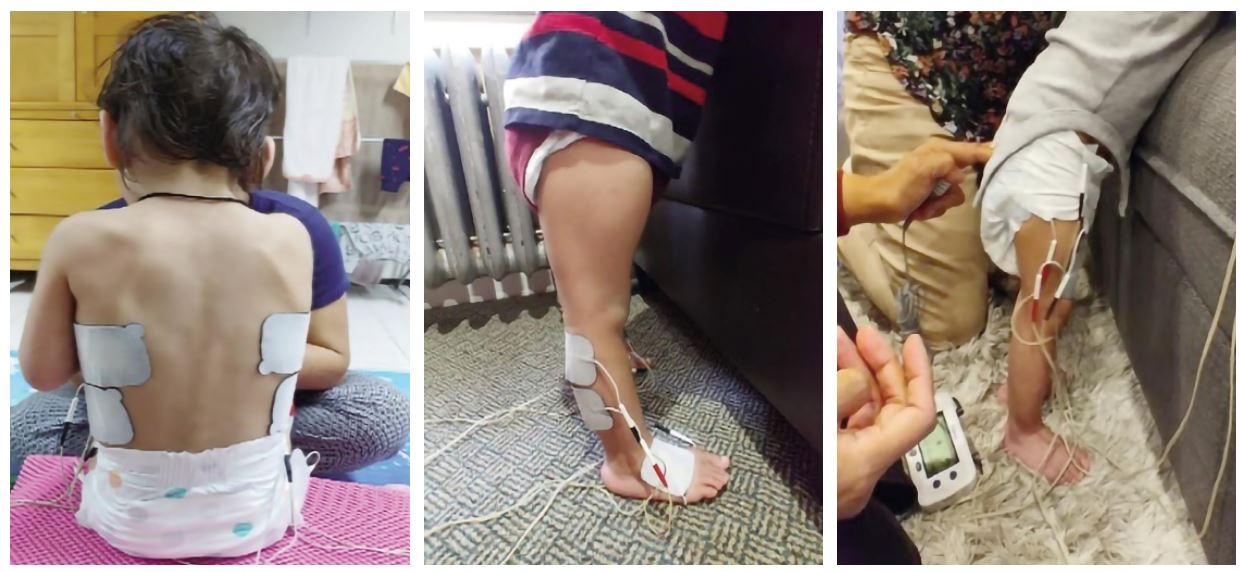
PART OF THE PROTOCOL: The best way for children with developmental diagnoses to achieve and maintain optimal health across all body systems is to help them engage in age-appropriate play and functional tasks. Electrical stimulation is a treatment modality that has well documented support as an intervention that produces good functional results when used in conjunction with functional task training, and when carried over in a home program.
HOW HAS THIS THERAPY BEEN MODIFIED FOR THE PEDIATRIC POPULATION?
Traditionally, clinicians have used adult protocols with their pediatric patients. These protocols do not take the developing system into account, and are often poorly tolerated by the child, leading to poor compliance. The approach described in this article is based on decades of work by various clinicians and researchers, and has been recently modified and taught by Dr. Susan Hastings, a renowned pediatric physical therapist. The differences in this approach relate to which muscles are targeted and the parameters that are used.
IS ELECTRICAL STIMULATION SAFE FOR CHILDREN?
ES is safe for most children and can be started as early as when a diagnosis is received. Age should not limit the use of estim, and in fact, there have been studies conducted using ES for children younger than 24 months. 3–5 There is a significant amount of research supporting this modality's efficacy and safety for children while using adult tested parameters, although there are reports of discomfort/pain. The parameters described in this paper are lower and specific for the pediatric system eliminating pain and discomfort as the side effect. Possible side effects may include dis-
comfort from the stimulation, however pediatric parameters are well tolerated. Discomfort from removing electrodes is similar to removing a Band-Aid. If the modality is used by an untrained practitioner or untrained parent there is risk of skin burn or fatigue to the muscle. However, a trained practitioner will understand precautions, contraindications and appropriate application. There are a number of contraindications/precautions beyond the scope of the article, but this is true for all therapeutic modalities. A trained practitioner should only opt to use this modality when it is appropriate for the patient. Medical clearance should be obtained for children with complex medical diagnoses, including: seizure disorders, shunts, or cardiac issues. ES can also help children who have received BOTOX and orthopedic procedures.
WHO CAN PROVIDE THIS INTERVENTION FOR MY CHILD?
Use of NMES and FES is within the scope of practice for physical therapists and no additional certification is needed. We do recommend that clinicians take continuing education courses to learn about pediatric settings. Occupational therapists are required to take a specified number of continuing education credits to train in the use of electrical stimulation prior to being allowed to use this modality.
WHAT IS THE COST OF THIS INTERVENTION? IS IT COVERED BY INSURANCE?
If a family is purchasing an e-stim unit for a home exercise program, the cost is between $350 and $425 and is typically not covered by insurance. The cost of therapeutic services using this modality will vary and insurance coverage will depend if the clinician is an in-network or out of network provider. Clinicians will use their units and use patient specific electrodes.
HOW DOES ELECTRICAL STIMULATION WORK?
Therapeutic electrical stimulation to a skeletal muscle can initiate an artificial physiological response by stimulating the nerves and influencing the connections to the brain and spinal cord. When this intervention is applied over time, it can improve motor function by reducing hypertonicity (high muscle tone), increasing muscle strength and muscle bulk, and improving gait (quality of walking). Principles of motor learning are used when using the FES, as described in this article. Motor learning is how the nervous system reorganizes itself to improve motor function through repeated practice of a functional task, leading to improved motor skill performance. The repetitive therapeutic electrical muscle stimulation facilitates motor learning when